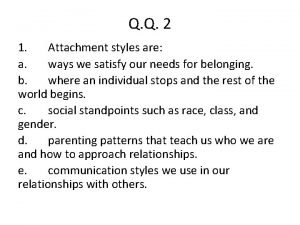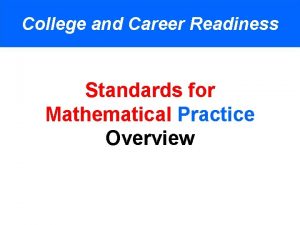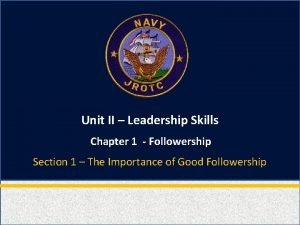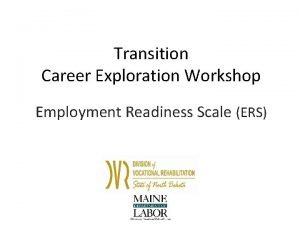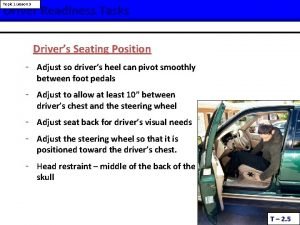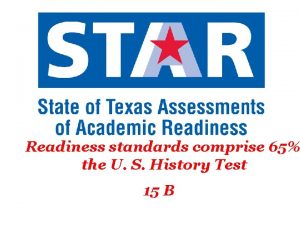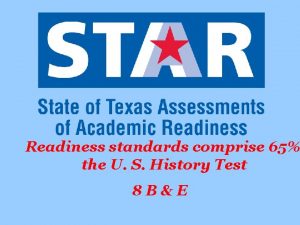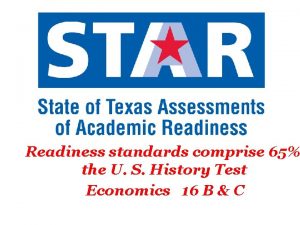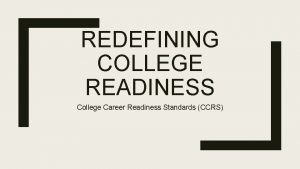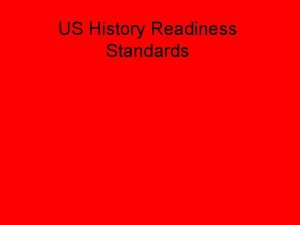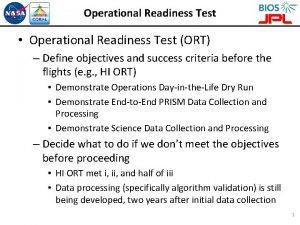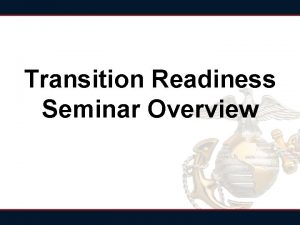Readiness standards comprise 65 the U S History

























































- Slides: 57

Readiness standards comprise 65% the U. S. History Test Economics 20 B

Readiness Standard (20) GOVERNMENT: The Student understands the changing relationships among the three branc of the federal government. The Student is expected to: (B) Evaluate the impact of relationships among the legislative, executive, & judici branches of government, including Frank D. Roosevelt’s attempt to increase the number of U. S. Supreme Court justices & the presidential election of 2000.

Readiness Standard (20) The Student understands the changing relationships among the three branches of th federal government. The Student is expected to: (B) 1 Evaluate the impact of relationship among the legislative, executive, & judici branches of government

U. S. CONSTITUTION & the Separation of Powers The Formation of U. S. Government— 1781 -1789 Which is better? Freedom or rules?

The Revolutionary War involved more than simply gaining independence from Britain. It concerned the unprecedented nature of establishing an elective system of government. The Americans had what one historian describes as a euphoric sense of “special destiny. ” The independent thinking colonials called into question the idea of “special aristocratic privilege. ” U. S. history is at one level a working out of the tensions between the forces of liberty and the forces of order

Flaws Within. The Articles the Articles of were rooted in Confederation (1781 -1789) fear of tyrannical Ratification came slowly because the power of the respective states disagreed over boundaries central to the west government— Too much power given to the states and too “power corrupts & little given to the federal government absolute power corrupts Very little power given to state absolutely” governors

Shays’ Rebellion (1787) Shays’ rebellion (right) was an armed uprising in western Massachusetts led by Daniel Shays (c. 17471825). The rebels vigorously protested high taxes and debts that the western Massachusetts farming community owed to the eastern banking establishment. The central government put down the rebellion. Shays’ Rebellion showed the dangers of what might happen—of a breakdown of law and order—without a strong central government.

The Framing of the Constitution (1787 -1789)

Constitutional Convention of 1787

The Discussion and Debate The New Jersey Plan—left states supreme over federal government (favored by the smaller states) The Virginia Plan—reduced the power of the states and increased the power of the federal government Although Edmund Randolph (right) proposed this plan on May 29, 1787, the written document was primarily the work of his fellow Virginian, James Madison.

Separation of powers French aristocrat and political philosopher Charles Louis de Secondat, Baron de la Brède et de Montesquieu, 1689 -1755 (left) wrote the multi-volume Esprit de lois (The Spirit of Laws), 1748. Among many other ideas, Montesquieu proposed the separation of powers to insure fair and equitable government. The Founding Fathers adopted the concept and applied it in the American Constitution. While the Founding Fathers accepted his idea of separation of powers, they rejected Montesquieu’s position that “a republican government could not flourish in a large territory. ”

Branches of American Government Executive Branch—Execute the law Legislative Branch—Make the law Judicial Branch—Interpret the law

If the Founding Fathers crafted a set of governing rules that have weathered the test of more than two centuries time, the governmental formula that they created is far from a hard and fast solution for all the conflicts that ar fated to emerge in a democratic society. Indeed, the Framers of the Constitution consciously fashioned thei product leaving sufficient flexibility—even certain intentional vagueness and ambiguity—making possible adjustments and adaptations along the way. They place immense confidence in the court system to interpret th “broad, general language” of the nation’s governing documents. Because the Constitution permits considera room for change with evolving tastes, preferences, norm and times, it virtually foreordains a measure of legal controversy.

But through the years, maintaining that balance between the three branches of government has not been without its challenges.

Congressional Plan—Radical Reconstruction, 1866 -1867 During these two years, Congress passed a series of acts nullifying Johnson’s program and reorganizing the South on its own terms. It was a Republican compromise The two leading Radical Republican politicians of the day: Charles Sumner (1811 -1874, above left) and Thaddeus Stevens (1792 -1868, above right)

The By-election of 1866 • Johnson aggressively campaigned nation-wide for candidates who supported his program for Reconstruction • He slandered his opponents in crude language • He engaged in undignified exchanges with hecklers • His behavior alienated Northern voters and Radical Republicans

Reconstruction Act of March 1867 • Adopt state constitution barring former Confederates from office • Grant African-American men the vote • Ratify the 14 th amendment • Military occupation for states until they were readmitted (all Southern states readmitted by 1871)

Readmission to the Union • The South was reorganized into five military districts • Quick readmission to the Union could be achieved for any state that framed and ratified a constitution providing for Black suffrage

Tenure of Office Act, 1867 • • Required approval of Senate for removal of Cabinet members or other officials whose appointment had required Congressional consent On February 21, 1868, Johnson dismissed the only Radical Republican Cabinet member, Secretary of War, Edwin Stanton (right—a Lincoln appointee)

The Upshot • Johnson ordered • Grant (eying the General U. S. Grant presidential nomination to replace Stanton of 1868) did not comply • Johnson appointed General Lorenzo Thomas to the post The House voted overwhelmingly on February 24, 1868, to put Johnson on trial—impeachment—for what representatives considered a violation of the Tenure of Office Act.

The Trial—March 25 -May 26, 1868

35 -19 Not Guilty Senator Ross (left) from Kansas denied the Radicals the 36 th vote that was necessary for conviction.

The Central Issue Should the President be impeached for “political” reasons? Richard M. Nixon, 1913 -1994, 37 th president President Bill Clinton (b. 1946), 42 nd president

If so, he/she is in fear of being removed for making an unpopular political decision • Such action threatened the constitutional balance of powers • It opened the way to legislative supremacy over the executive

Although Johnson’s impeachment did not remove him from office. . . • . . . it overturned the constitutional balance of power between the executive & legislative branches • That balance was not fully restored until the administration of Theodore Roosevelt (1901 -1908)

Theodore Roosevelt’s Rise to the Presidency

Leon Czolgosz Mc. Kinley’s Assassination

Mc. Kinley’s Vice-Presidential Running Mate When Mc. Kinley needed a new vicepresidential running mate in 1890, Thomas Platt, the New York political machine boss, saw to it that Theodore Roosevelt became the vice-president in order to get rid of him. To be named to the ticket as the vice-president was not an honor, but a political coffin. Mark Hanna was uncomfortable with Theodore Roosevelt and called him “that d****d cowboy. ” He asked Mc. Kinley what would happen to the country should Theodore Roosevelt become President?

Election of 1904 Candidate Popular Vote Electoral Vote Roosevelt 7. 6 million 336 Parker 5. 1 million 140 Debs 402, 489 0

1904 Continued • TR won 57% of the vote to Democratic candidate Alton B. Parker’s 38% • The victory allayed TR’s fears that he was but an “accidental president” • His victory opened the way for a comprehensive reform program that began in 1904 & fully demonstrated that the power of the executive branch was, if anything, superior to the legislative

Readiness Standard (20) The Student understands the changing relationships among the three branches of th federal government. The Student is expected to: (B) 2 Evaluate the impact of Franklin D. Roosevelt’s attempt to increase the numbe of U. S. Supreme Court justices

Unconstitutional New Deal laws • National Industrial Recovery Act—federal government cannot regulate commerce within a state • Agricultural Adjustment Act—government cannot tax one part of the population to help another FDR’s Adversaries: The “Nine Old Men”

Roosevelt’s plan to “pack” the Supreme Court By appointing more judges, FDR hoped to break the roadblock erected by the Supreme Court in blocking or declaring unconstitutional certain New Deal legislation. FDR wanted to create a sympathetic majority through his “Court -Packing Scheme. ” Privately the president derisively referred to the Court as the “Nine Old Men. ” The president suggested that the Court had fallen behind schedule since there were numerous elderly justices among the nine. In fact, the Court was quite up to date.

The president’s proposal created one new justice for every Court member over age 70 (up to a maximum of six new members). The Senate blocked FDR’s proposal. The Court of the 1930 s appears to above. Justice Willis Van Devanter (right) particularly frustrated the president. Although elderly, he refused to retire because he considered FDR “unfitted and unsafe for the presidency. ” “The court fight had badly weakened the president’s relations with Congress, opening up deep rifts with members of his own party. ”

Readiness Standard (20) The Student understands the changing relationships among the three branches of th federal government. The Student is expected to: (B) 3 Evaluate the impact of the president election of 2000.

Electoral College to select the president— guaranteed that the chief executive would not be indebted to Congress for his office

There have been four U. S. elections in which have had to be determined in the House of Representatives or by other extraordinary means

Thomas Jefferson vs. Aaron Burr 1800 It took 36 ballots in the House to break the deadlock when the leading Federalists broke with Burr and threw support to Jefferson. Both Jefferson (left, 17431826) and Aaron Burr (right, 1756 -1836) received 73 electoral votes throwing the decision to select the next president into the House of Representatives. This amendment eliminated the possibility that the candidate receiving the second most votes would automatically become vice-president. Subsequently, Congress passed the Twelfth Amendment providing for election of the president and vice-president by the electoral college.

John Quincy Adams vs. Andrew Jackson, 1824 The election of 1824 resulted in the loss of the candidate with the most popular votes

Election of 1824 Andrew Jackson, 17671845 John Quincy Adams, 17671848 The Scorecard William Crawford, 1772 -1834

Birth of the Second Party System— Election of 1824 • The election brings an end of the Era of Good Feelings and the birth of the Second Party System. The year 1825 also saw a “return to prosperity” in the U. S. • Virginia Dynasty— 4/5 th of presidents had been from Virginia (all the Republicans were Virginians) • The unity of the Era of Good Feelings would shatter as the Republican Party began to fracture into different camps with different political agendas. The Republicans were in disarray in 1824 • Emergence of Democrats and Whigs as two principal parties

Monroe’s successor was to be Secretary of State, John Quincy Adams, not Jackson, who was seen by many as a Federalist in disguise • A Nationalist • Government should exercise power in shaping society and economy and assist the growth of business and industry • Federally financed internal improvements • Favored Banks and paper money • Promotion of business growth via a protective tariff

Candidacy of Andrew Jackson • The hero of New Orleans and Indian campaigns • He ran on his name and reputation. His military record was his sole claim to fame • Jackson came to symbolize the triumph of democracy in America • His only issues were his dislike of banks, especially the Bank of the U. S. , and paper money • He especially disliked the fact that government policies favored business and industry

Election of Adams in 1824 Since there was no electoral majority, according to the 12 th Amendment, Congress—the House of Representatives—was to select, voting by state, among the top candidates (Jackson, Crawford and Adams). Consequently, John Quincy Adams became president by vote of the House of Representatives.

A Qualified Victory • Since Jackson was the popular and electoral leader, he felt he should be and would be chosen president • Adams “assumed office under a cloud of suspicion. Adams had a difficult and frustrating presidency” • “The political winds were blowing against nationalist programs. . . [and] Adams refused to bow to public opinion”

Rutherford B. Hayes vs. Samuel J. Tilden, 1876 Tilden had won 184 electoral votes to Hayes's 165, with 20 votes unresolved. One of the most contentious and controversial presidential elections in American history. The results remain among the most disputed ever, although there is no question that Tilden of New York outpolled Ohio’s Hayes in the popular vote. An informal deal was struck resulting in the so-called “Compromise of 1877. ” It awards all 20 votes to Hayes.

The Election of 1876 was hotly contested as the flanking cartoons suggest. In the end, Rutherford B. Hayes received the winning number of electoral votes in spite of the fact that Democrat Samuel Tilden garnered more of the popular vote. Election of 1876

Election of 1876 Rutherford B. Hayes ultimately won the election of 1876—above, electoral vote is cast

Election of 1876 Samuel J. Tilden, 18141886 But How? Hayes Wins Rutherford B. Hayes, 1822 -1893

The “Compromise of 1877” • • Federal aid to build new Southern railroads Federal aid to build flood controls along the Mississippi River Removal of last federal troops from the South (April 1877) Promise from Southerners to treat African -Americans fairly, protect their rights

For all intents and purposes, Hayes extended “Home Rule” to the South “In fact, Hayes abandoned Southern Blacks “to their fate. . [Moreover, ] the entire South was firmly under the control of white Democrats. The trauma of the war and Reconstruction had destroyed the chances for a renewal of two-party competition among white Southerners. ”

The New South • • Rule of the “Redeemers”—late-1870 s 1880 s involving: The restoration of the planter class of the Old South Those of middle class origin and outlook who favored commercial interests and industrial development over agrarian groups The rise of professional politicians

George W. Bush vs. Al Gore 2000. . . two full centuries after Jefferson vs. Burr Election results hinged on Florida, where the margin of victory triggered a mandatory recount. Litigation in select counties started additional recounts, and this litigation ultimately reached the U. S. Supreme Court. The Court’s contentious decision in Bush v. Gore (in contrast to an equally contentious decision by the Florida State Supreme Court), announced on December 12, 2000, ended the recounts, effectively awarding Florida's votes to Bush and granting him the victory.

The President and Vice President are not elected directly by the voters. Instead, they are elected by “electors” who are chosen by popular vote on a stateby-state basis. Electors are apportioned to each state & the District of Columbia The number of electors in each state is equal to the number of members of Congress to which the state is entitled. In total, there are 538 electors, based on there being 435 representatives and 100 senators, plus the three electors from the District of Columbia.

Electoral College to select the president— this guarantees that the chief executive would not be indebted to Congress for his office

DETAILS

Fini
 What comprise a community
What comprise a community Marketing management
Marketing management The views of ____ comprise the generalized other.
The views of ____ comprise the generalized other. Particular synoynm
Particular synoynm College and career readiness standards math
College and career readiness standards math Factors necessary for service standards are
Factors necessary for service standards are Hát kết hợp bộ gõ cơ thể
Hát kết hợp bộ gõ cơ thể Frameset trong html5
Frameset trong html5 Bổ thể
Bổ thể Tỉ lệ cơ thể trẻ em
Tỉ lệ cơ thể trẻ em Chó sói
Chó sói Thang điểm glasgow
Thang điểm glasgow Chúa yêu trần thế alleluia
Chúa yêu trần thế alleluia Môn thể thao bắt đầu bằng chữ đua
Môn thể thao bắt đầu bằng chữ đua Thế nào là hệ số cao nhất
Thế nào là hệ số cao nhất Các châu lục và đại dương trên thế giới
Các châu lục và đại dương trên thế giới Công của trọng lực
Công của trọng lực Trời xanh đây là của chúng ta thể thơ
Trời xanh đây là của chúng ta thể thơ Mật thư tọa độ 5x5
Mật thư tọa độ 5x5 Phép trừ bù
Phép trừ bù Phản ứng thế ankan
Phản ứng thế ankan Các châu lục và đại dương trên thế giới
Các châu lục và đại dương trên thế giới Thể thơ truyền thống
Thể thơ truyền thống Quá trình desamine hóa có thể tạo ra
Quá trình desamine hóa có thể tạo ra Một số thể thơ truyền thống
Một số thể thơ truyền thống Bàn tay mà dây bẩn
Bàn tay mà dây bẩn Vẽ hình chiếu vuông góc của vật thể sau
Vẽ hình chiếu vuông góc của vật thể sau Biện pháp chống mỏi cơ
Biện pháp chống mỏi cơ đặc điểm cơ thể của người tối cổ
đặc điểm cơ thể của người tối cổ V cc
V cc Vẽ hình chiếu đứng bằng cạnh của vật thể
Vẽ hình chiếu đứng bằng cạnh của vật thể Tia chieu sa te
Tia chieu sa te Thẻ vin
Thẻ vin đại từ thay thế
đại từ thay thế điện thế nghỉ
điện thế nghỉ Tư thế ngồi viết
Tư thế ngồi viết Diễn thế sinh thái là
Diễn thế sinh thái là Các loại đột biến cấu trúc nhiễm sắc thể
Các loại đột biến cấu trúc nhiễm sắc thể Các số nguyên tố
Các số nguyên tố Tư thế ngồi viết
Tư thế ngồi viết Lời thề hippocrates
Lời thề hippocrates Thiếu nhi thế giới liên hoan
Thiếu nhi thế giới liên hoan ưu thế lai là gì
ưu thế lai là gì Khi nào hổ mẹ dạy hổ con săn mồi
Khi nào hổ mẹ dạy hổ con săn mồi Khi nào hổ mẹ dạy hổ con săn mồi
Khi nào hổ mẹ dạy hổ con săn mồi Sơ đồ cơ thể người
Sơ đồ cơ thể người Từ ngữ thể hiện lòng nhân hậu
Từ ngữ thể hiện lòng nhân hậu Thế nào là mạng điện lắp đặt kiểu nổi
Thế nào là mạng điện lắp đặt kiểu nổi Also history physical
Also history physical Young worker readiness
Young worker readiness Workplace readiness skills positive work ethics
Workplace readiness skills positive work ethics School readiness goals
School readiness goals What is follower readiness
What is follower readiness Employment readiness scale assessment
Employment readiness scale assessment Bge mirror settings will
Bge mirror settings will Task analysis toileting
Task analysis toileting Trl
Trl Test readiness review
Test readiness review


